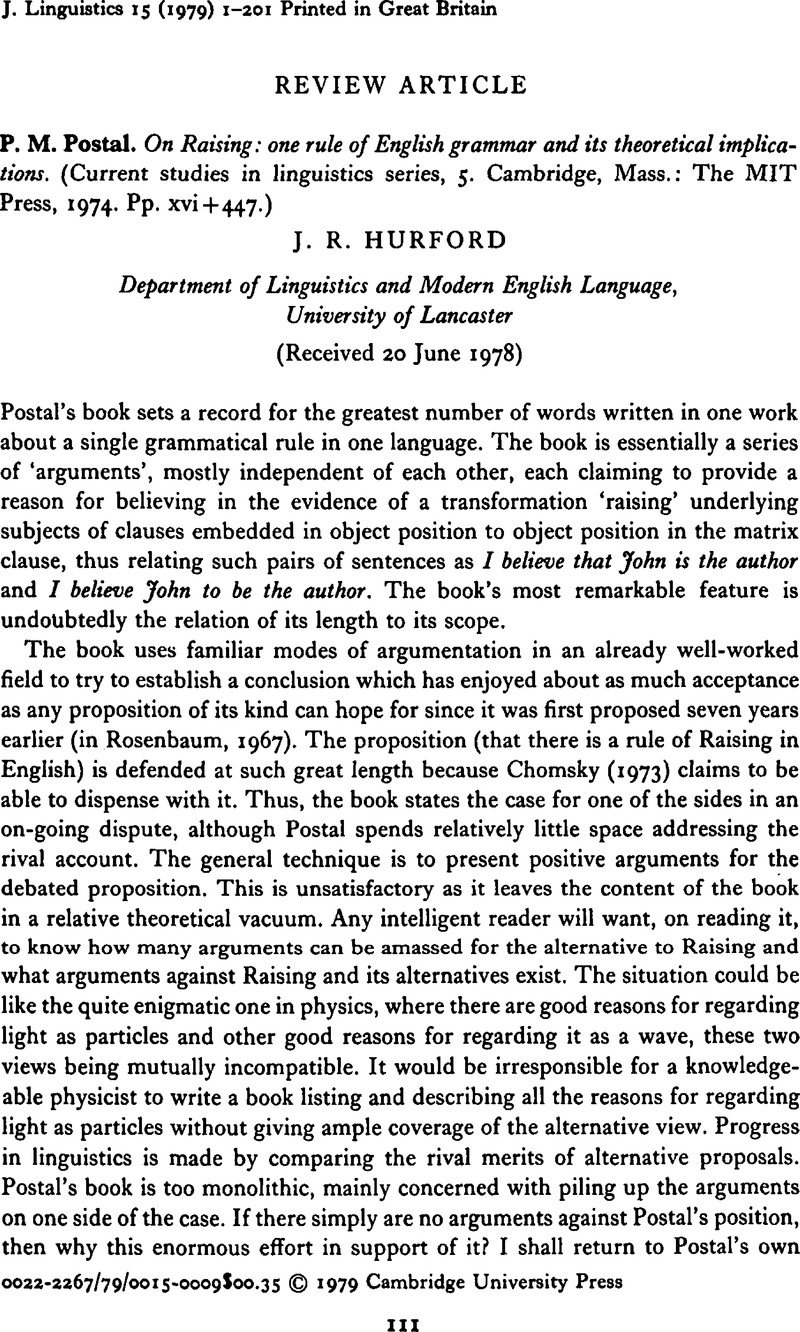No CrossRef data available.
Article contents
On Raising: one rule of English grammar and its theoretical implications
Published online by Cambridge University Press: 28 November 2008
Abstract
An abstract is not available for this content so a preview has been provided. Please use the Get access link above for information on how to access this content.

- Type
- Review Article
- Information
- Copyright
- Copyright © Cambridge University Press 1979
References
REFERENCES
Bach, E. (1977). Review article on Postal, P. M. (1974) On Raising (Cambridge, Mass.: MIT Press). Lg 53. 621–654.Google Scholar
Bresnan, J. (1970). On complementizers: towards a syntactic theory of complement types. FL 6. 297–321.Google Scholar
Botha, R. P. (1976). ‘The theory comparison method’ vs, ‘the theory exposition method’ in linguistic inquiry. Bloomington, Indiana: Indiana University Linguistics Club.Google Scholar
Chomsky, N. (1970). Remarks on nominalizations. In Jacobs, R. A. & Rosenbaum, P. S. (eds), Readings in English transformational grammar. Waltham, Mass.: Ginn & Co.Google Scholar
Chomsky, N. (1973). Conditions on transformations. In Anderson, S. R. & Kiparsky, P. (eds), A Festschrift for Morris Halle. New York: Holt, Rinehart & Winston.Google Scholar
Dougherty, R. C. (1973). A survey of linguistic methods and arguments. FL 10. 423–490.Google Scholar
Fodor, J. A. (1970). Three reasons for not deriving ‘kill’ from ‘cause to die’. LIn. 1 429–438.Google Scholar
Hurford, J. R. (1973). Deriving S from S +is. In Kimball, J. (ed.), Syntax and semantics, Vol. 2. New York: Seminar Press.Google Scholar
Klima, E. S. (1964). Negation in English. In Fodor, J. A. & Katz, J. J. (eds) The structure of language. Englewood Cliffs. N.J.: Prentice-Hall.Google Scholar
Lightfoot, D. (1976). The theoretical implications of subject raising. FL 14. 257–285.Google Scholar
Postal, P. M. (1972). The best theory. in Peters, S. (ed.), Goals of linguistic theory. Englewood Cliffs, N.J.: Prentice-Hall.Google Scholar
Rosenbaum, P. S. (1967). The grammar of English predicate complement constructions. Cambridge, Mass.: MIT Press.Google Scholar
Ross, J. R. (1969). Adjectives as noun phrases. In Reibel, D. & Schane, S. (eds), Modern studies in English. Englewood Cliffs, N.J.: Prentice-Hall.Google Scholar
Ross, J. R. (1970). On declarative sentences. In Jacobs, R. A. & Rosenbaum, P. S. (eds), Readings in English transformational grammar. Waltham, Mass.: Ginn & Co.Google Scholar


